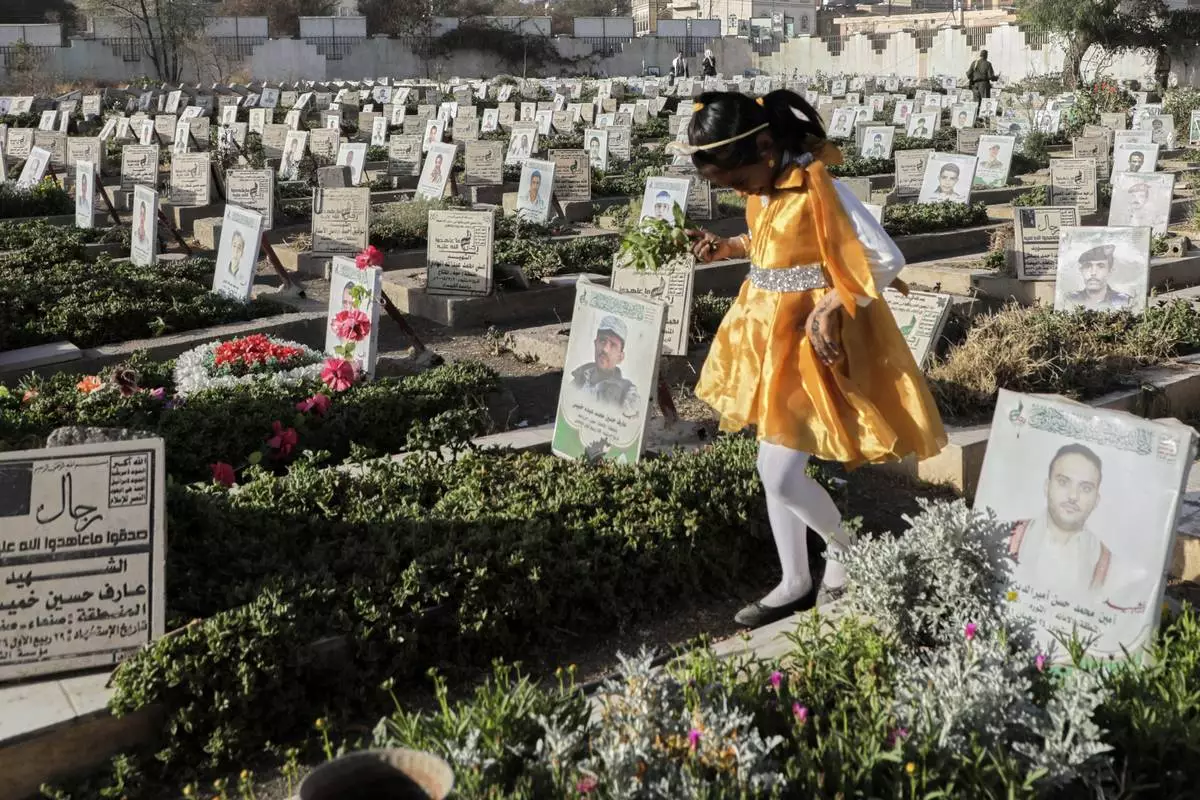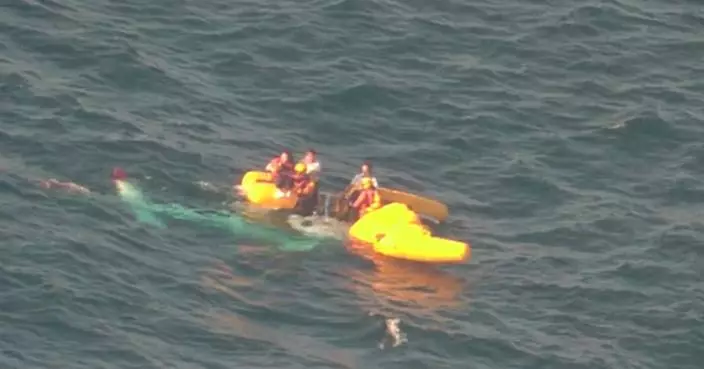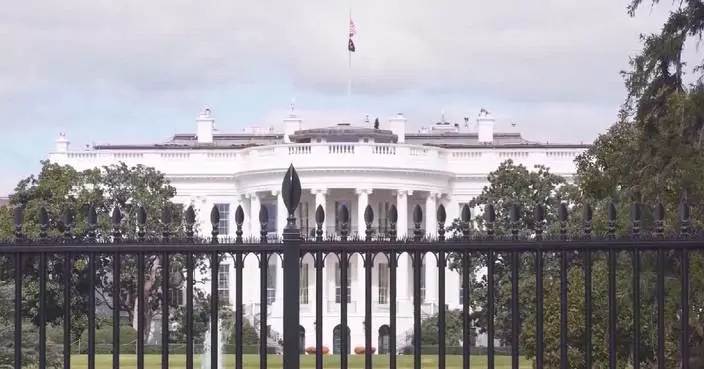FRANKFURT, Germany (AP) — Inflation in Europe eased to an annual 2.4% in February, supporting the case for another interest rate cut from the European Central Bank - but leaving open how far the central bank will go in lowering borrowing costs for an economy that's still struggling to show robust growth.
The February figure for the 20 countries that use the euro currency was down from 2.5% in January as energy inflation dwindled and major economy France saw a rate of only 0.9%, the European Union's statistical agency Eurostat reported Monday.
The lower consumer price inflation figure supports the view that the ECB is succeeding in its battle to get inflation back to its target of 2% and can focus on supporting tepid growth. The bank's rate-setting council is expected to cut its benchmark rate by a quarter point to 2.5% on Thursday. That rate influences borrowing costs throughout the economy, and a cut will make it easier to borrow money to buy a house or expand a factory.
A rate cut Thursday had already been pencilled in by analysts but the new figure gives added support for a cut.
Growth worries have come to the fore after the eurozone stagnated in the last three months of 2024, as consumers still smarting from an outbreak of inflation remained cautious in their spending habits. Business worried about possible new tariffs on exports to the US under President Donald Trump. Political paralysis in France, where no party has a majority in parliament to address an outsized budget deficit, and the transition to a new government in Germany after the Feb. 23 national election have also left businesses uncertain about the future.
Recent surveys of purchasing managers by S&P Global suggested the eurozone economy just barely grew in February.
The big question at Thursday's interest rate meeting is whether bank President Christine Lagarde will drop clues about how far the bank will go in cutting rates. While inflation is well down from its peak of 10.6% in October, 2022, some indicators of prices pressures remain elevated. Costs for services — a broad category ranging from haircuts and hotel rooms to concert tickets and medical care — remained at 3.7%
At its last meeting on Jan. 30, the bank said the benchmark rate was still high enough to restrict growth; dropping that mention on Thursday could be seen as a signal that future cuts will be more limited.
A top ECB official argued in a recent speech that recent changes in the economy may constrain how far the bank can go in cutting rates.
Recent evidence suggests “that the era during which risks to inflation have persistently been to the downside is likely to have come to an end,” said Isabel Schnabel, a member of the six-member executive board that runs the bank day to day at its Frankfurt headquarters. Schnabel argued that the so-called neutral rate at which the economy is neither held back nor stimulated has risen in recent years.

FILE - The European Central Bank is pictured in Frankfurt, Germany, Wednesday, Jan. 24, 2024. (AP Photo/Michael Probst, File)
DUBAI, United Arab Emirates (AP) — Suspected U.S. airstrikes over the weekend targeting Yemen's Houthi rebels killed at least six people, the group said Sunday, while a bombing video posted by U.S. President Donald Trump suggested casualties in the overall campaign may be higher than the rebels acknowledge.
A strike Sunday night in Sanaa, the rebel-held capital of Yemen, hit a house, killing at least four people and wounding 16 others, the Houthis said. Their al-Masirah satellite news channel showed images of the damaged home and people receiving care in a hospital.
The strike on the house in Sanaa's Shu’ub district allegedly targeted a Houthi leader, part of a wider decapitation campaign launched by the Trump administration to kill rebel leaders. The intense campaign of U.S. airstrikes targeting the rebels over their attacks on shipping in Mideast waters — related to the Israel-Hamas war — has killed at least 73 people, according to casualty figures released by the Houthis.
Earlier Sunday, the Iranian-backed Houthis said other suspected U.S. airstrikes killed at least two people in the rebel stronghold of Saada and wounded nine others. Footage aired by al-Masirah showed a strike collapsing what appeared to be a two-story building. The rebels aired no footage from inside the building, which they described as a solar power shop.
The Houthis have not acknowledged any casualties among their security and military leadership — something challenged after an online video posted by Trump.
Early on Saturday, Trump posted what appeared to be black-and-white video from a drone showing over 70 people gathered in a circle. An explosion detonates during the 25-second video. A massive crater is left in its wake.
“These Houthis gathered for instructions on an attack,” Trump claimed, without offering a location or any other details about the strike. “Oops, there will be no attack by these Houthis! They will never sink our ships again!”
The U.S. military's Central Command, which oversees Mideast military operations, has not published the video nor offered specific details about the strikes it has conducted since March 15. The White House has said over 200 strikes have targeted the Houthis.
The rebel-controlled SABA news agency in Yemen, citing an anonymous source, described the bombing as targeting “a social Eid visit in Hodeida governorate.” Muslims around the world just celebrated Eid al-Fitr at the end of the holy Muslim fasting month of Ramadan. SABA had published images of other commanders meeting fighters during the holiday, though not any high-level Houthi officials.
“Those present at that gathering had no connection to the operations carried out by the (Houthis), which are implementing the decision to ban navigation on ships linked to the American and Israeli enemy,” the SABA report said, adding that the attack killed and wounded “dozens.”
The Houthis previously have not acknowledged any strike on Hodeida during that time with such a high casualty count. The SABA report also did not describe those killed as civilians, suggesting they did have ties to the rebels' security or military forces. Hodeida has been a site of Houthi attacks into the Red Sea.
Moammar al-Eryani, the information minister for Yemen's exiled government opposing the Houthis, claimed the strike killed some 70 Houthi fighters and leaders, as well as “experts” from Iran's paramilitary Revolutionary Guard. He offered no evidence for the claim, though Iran has backed the Houthis. Neither the Iranian government nor the Guard has acknowledged the attack.
Mohammed al-Basha, a Yemen expert of the Basha Report risk advisory firm, cited social media condolence notices suggesting a colonel overseeing police stations for the Houthis in Hodeida had been killed in the strike Trump highlighted, alongside his two brothers.
“The strikes have expanded significantly, hitting multiple governorates simultaneously, alongside telecommunications infrastructure, command nodes, properties tied to senior Houthi leadership and previously untouched tunnel networks in mountainous areas,” al-Basha told The Associated Press.
“We’ve also seen direct targeting of Houthi force gatherings, indicating a more aggressive and evolving shift in the targeting strategy,” al-Basha said.
An AP review has found the new U.S. operation against the Houthis under Trump appears more extensive than those under former President Joe Biden, as Washington moves from solely targeting launch sites to firing at ranking personnel and dropping bombs on cities.
The new campaign of airstrikes started after the rebels threatened to begin targeting “Israeli” ships again over Israel blocking aid entering the Gaza Strip. The rebels have loosely defined what constitutes an Israeli ship, meaning many vessels could be targeted.
The Houthis targeted more than 100 merchant vessels with missiles and drones, sinking two of them and killing four sailors from November 2023 until January of this year. They also launched attacks targeting American warships without success.
The attacks greatly raised the profile of the Houthis, who faced economic problems and launched a crackdown targeting dissent and aid workers in Yemen amid a decadelong stalemated war that has torn apart the Arab world’s poorest nation.
The U.S. campaign shows no signs of stopping, as the Trump administration has linked its airstrikes on the Houthis to an effort to pressure Iran over its rapidly advancing nuclear program.
Associated Press writer Samy Magdy in Cairo contributed to this report.

A Yemeni girl visits the graves of Houthis during Eid al-Fitr marking the end of the holy fasting month of Ramadan in Sanaa, Yemen, Sunday, March 30, 2025. (AP Photo/Osamah Abdulrahman)


















































